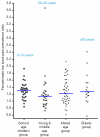Increased low back pain prevalence in females than in males after menopause age: evidences based on synthetic literature review
- PMID: 27190772
- PMCID: PMC4858456
- DOI: 10.21037/qims.2016.04.06
Increased low back pain prevalence in females than in males after menopause age: evidences based on synthetic literature review
Abstract
Female sex hormones play an important role in the etiology and pathophysiology of a variety of musculoskeletal degenerative diseases. Postmenopausal women show accelerated disc degeneration due to relative estrogen deficiency. This literature review aims to validate or falsify this hypothesis, i.e., while overall females have higher prevalence of low back pain (LBP) across all age groups, this male vs. female difference in LBP prevalence further increases after female menopause age. The literature search was performed on PubMed on January 2, 2016. The search word combination was (low back pain) AND prevalence AND [(males OR men) AND (females OR women)]. The following criteria were taken to include the papers for synthetic analysis: (I) only English primary literatures on nonspecific pain; (II) only prospective studies on general population, but not population with occupational LBP causes, of both males and female subjects studied using the same LBP criterion, ages-specific information available, and males and female subjects were age-matched; (III) studies without major quality flaws. In total 98 studies with 772,927 subjects were analyzed. According to the information in the literature, participant subjects were divided into four age groups: (I) school age children group: 6-19 years; (II) young and middle aged group: 20-50 years; (III) mixed age group: data from studies did not differentiate age groups; (IV) elderly group: ≥50 years old. When individual studies were not weighted by participant number and each individual study is represented as one entry regardless of their sample size, the median LBP prevalence ratio of female vs. males was 1.310, 1.140, 1.220, and 1.270 respectively for the four age groups. When individual studies were weighted by participant number, the LBP prevalence ratio of female vs. males was 1.360, 1.127, 1.185, and 1.280 respectively for the four groups. The higher LBP prevalence in school age girls than in school age boys is likely due to psychological factors, female hormone fluctuation, and menstruation. Compared with young and middle aged subjects, a further increased LBP prevalence in females than in males was noted after menopause age.
Keywords: Physiological gender difference; epidemiology; intervertebral disc degeneration; low back pain (LBP); menopause; menstruation.
Conflict of interest statement
Figures



Similar articles
-
Menopause as a potential cause for higher prevalence of low back pain in women than in age-matched men.J Orthop Translat. 2016 Jun 14;8:1-4. doi: 10.1016/j.jot.2016.05.012. eCollection 2017 Jan. J Orthop Translat. 2016. PMID: 30035087 Free PMC article.
-
The association between lumbar disc degeneration and low back pain: the influence of age, gender, and individual radiographic features.Spine (Phila Pa 1976). 2010 Mar 1;35(5):531-6. doi: 10.1097/BRS.0b013e3181aa5b33. Spine (Phila Pa 1976). 2010. PMID: 20147869
-
The association of combination of disc degeneration, end plate signal change, and Schmorl node with low back pain in a large population study: the Wakayama Spine Study.Spine J. 2015 Apr 1;15(4):622-8. doi: 10.1016/j.spinee.2014.11.012. Epub 2014 Nov 27. Spine J. 2015. PMID: 25433277
-
Epidemiology of juvenile low back pain: a review.Disabil Rehabil. 1997 Dec;19(12):505-12. doi: 10.3109/09638289709166043. Disabil Rehabil. 1997. PMID: 9442988 Review.
-
Musculoskeletal Low Back Pain in School-aged Children: A Review.JAMA Pediatr. 2017 Mar 1;171(3):280-287. doi: 10.1001/jamapediatrics.2016.3334. JAMA Pediatr. 2017. PMID: 28135365 Review.
Cited by
-
Raloxifene Stimulates Estrogen Signaling to Protect Against Age- and Sex-Related Intervertebral Disc Degeneration in Mice.Front Bioeng Biotechnol. 2022 Aug 11;10:924918. doi: 10.3389/fbioe.2022.924918. eCollection 2022. Front Bioeng Biotechnol. 2022. PMID: 36032728 Free PMC article.
-
Does the risk of chronic low back pain depend on age at menarche or menopause? A population-based cross-sectional and cohort study: the Trøndelag Health Study.BMJ Open. 2022 Feb 24;12(2):e055118. doi: 10.1136/bmjopen-2021-055118. BMJ Open. 2022. PMID: 35210341 Free PMC article.
-
Eicosapentaenoic Acid-Induced Autophagy Attenuates Intervertebral Disc Degeneration by Suppressing Endoplasmic Reticulum Stress, Extracellular Matrix Degradation, and Apoptosis.Front Cell Dev Biol. 2021 Nov 4;9:745621. doi: 10.3389/fcell.2021.745621. eCollection 2021. Front Cell Dev Biol. 2021. PMID: 34805156 Free PMC article.
-
Is Pelvic Floor Dysfunction Associated With Development of Transient Low Back Pain During Prolonged Standing? A Protocol.Clin Med Insights Womens Health. 2019 May 27;12:1179562X19849603. doi: 10.1177/1179562X19849603. eCollection 2019. Clin Med Insights Womens Health. 2019. PMID: 31205437 Free PMC article.
-
Effects of a tailored mat-Pilates exercise program for older adults on pain, functioning, and balance in women with chronic non-specific low back pain: a randomized controlled trial.Aging Clin Exp Res. 2023 Dec;35(12):3059-3071. doi: 10.1007/s40520-023-02604-7. Epub 2023 Nov 7. Aging Clin Exp Res. 2023. PMID: 37934400 Clinical Trial.
References
LinkOut - more resources
Full Text Sources
Other Literature Sources
Miscellaneous
